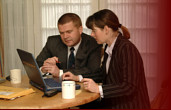


Copyright © 2006 by Michael Boone & Associates · All Rights reserved

The Sales Triangle - Part Two "Skills"

Michael Boone & Associates Newsletter
The Sales Triangle - Part Two "Skills" June 1, 2005
Greetings!
We recently began a series of newsletters on the three parts of a selling triangle. We first addressed "attitude". This week we'll be writing about skills - the second side of the triangle.
In this issue:
• Do You Have A Question?
• The Sales Triangle - Part Two "Skills"
The Sales Triangle - Part Two "Skills" June 1, 2005
Greetings!
We recently began a series of newsletters on the three parts of a selling triangle. We first addressed "attitude". This week we'll be writing about skills - the second side of the triangle.
In this issue:
• Do You Have A Question?
• The Sales Triangle - Part Two "Skills"
In a previous newsletter, we talked about the first leg of the "Triangle" so today we'll move to the second part - "skill." A professional salesperson realizes that attitude alone will not create "sales success." Professional selling means the development of selling skills. When salespeople fail to develop the fundamental skills that are vital to their career, they do what we term "accidental selling." I was guilty in my first years of selling.
When I started my career, I was encouraged to "get into sales because I had a good personality" - like that is all you needed to enjoy a successful selling career.
On my first two jobs, I had success in "accidental selling" because I was in the right place at the right time. Because I was young and had a growing family, I had to be successful so I would make enough calls each work day that I would find someone who needed and wanted my services; however, this method took a lot of time, energy and intensity. I was receiving rejection over and over again and "burn out" was beginning to set in. I wanted to go back to delivering newspapers because nobody rejected me at 4:30 in the morning.
Lucky for me, I ran across a good professional sales trainer. He pointed out to me that only 10% of the people I was calling on were very unhappy with their provider and wanted my services at that time and that only 10% were very happy with their current provider and would not consider a change. Now that meant 80% were just " O. K." and saw no "real reason" to change. When I had successes, I was limiting my success to the 10% that was very unhappy. Additionally, I was growing very frustrated with the other "happy" group who would not even talk to me.
What I did not know was how to solicit that 80% "just O. K." market. Unfortunately for me at that time, my best and largest prospects were a part of that group. He went on to point out that if I was to be successful, I would need to focus on that 80% market;and, in order to approach that market, I need to develop the skills of selling; and those skills were:
How to approach the prospect, lower the defense barriers, establish rapport and arouse interest.
If I was to be successful in my approach, then how would I determine the needs? If I found the prospect had needs (and the prospect agreed as to those needs), then I would need to ask myself, If the situation was reversed, would I change services and buy what I was selling. If I could answer that question in the affirmative, then I was ready for the next step.
Now my next step would be to determine what I needed to present to that prospect that would satisfy his needs. If we could agree there was value in my statements, then I could go to "a close" - get a commitment from this prospect to take some action in the future.
The trainer went on to say that I didn't need to ask for an order at this point, but simply for a "fair basis for comparison." He pointed out that a "next" order request, if granted, might be the hardest order I would ever have and that the worst thing that could happen to my relationship at that point would be for it to be dependent on my ability to fill that "impossible" order.
In summary, I needed to develop: Approach, Need Determination, Presentation and Close
When I developed these steps, I increased my effectiveness by 500%. We will discuss each of these skills in the future. Stay tuned!
When I started my career, I was encouraged to "get into sales because I had a good personality" - like that is all you needed to enjoy a successful selling career.
On my first two jobs, I had success in "accidental selling" because I was in the right place at the right time. Because I was young and had a growing family, I had to be successful so I would make enough calls each work day that I would find someone who needed and wanted my services; however, this method took a lot of time, energy and intensity. I was receiving rejection over and over again and "burn out" was beginning to set in. I wanted to go back to delivering newspapers because nobody rejected me at 4:30 in the morning.
Lucky for me, I ran across a good professional sales trainer. He pointed out to me that only 10% of the people I was calling on were very unhappy with their provider and wanted my services at that time and that only 10% were very happy with their current provider and would not consider a change. Now that meant 80% were just " O. K." and saw no "real reason" to change. When I had successes, I was limiting my success to the 10% that was very unhappy. Additionally, I was growing very frustrated with the other "happy" group who would not even talk to me.
What I did not know was how to solicit that 80% "just O. K." market. Unfortunately for me at that time, my best and largest prospects were a part of that group. He went on to point out that if I was to be successful, I would need to focus on that 80% market;and, in order to approach that market, I need to develop the skills of selling; and those skills were:
How to approach the prospect, lower the defense barriers, establish rapport and arouse interest.
If I was to be successful in my approach, then how would I determine the needs? If I found the prospect had needs (and the prospect agreed as to those needs), then I would need to ask myself, If the situation was reversed, would I change services and buy what I was selling. If I could answer that question in the affirmative, then I was ready for the next step.
Now my next step would be to determine what I needed to present to that prospect that would satisfy his needs. If we could agree there was value in my statements, then I could go to "a close" - get a commitment from this prospect to take some action in the future.
The trainer went on to say that I didn't need to ask for an order at this point, but simply for a "fair basis for comparison." He pointed out that a "next" order request, if granted, might be the hardest order I would ever have and that the worst thing that could happen to my relationship at that point would be for it to be dependent on my ability to fill that "impossible" order.
In summary, I needed to develop: Approach, Need Determination, Presentation and Close
When I developed these steps, I increased my effectiveness by 500%. We will discuss each of these skills in the future. Stay tuned!